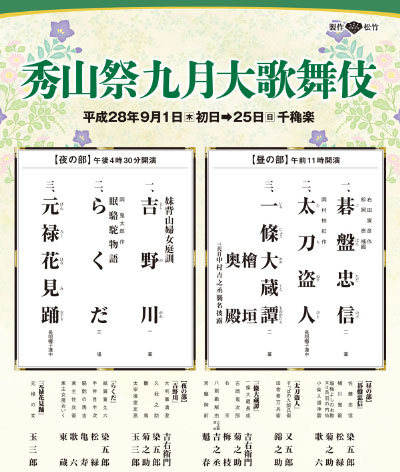| SEPTEMBER 2016 |
|
3 shows in T˘ky˘ (Kabukiza, Asakusa K˘kaid˘), 1 show in ďsaka (Morinomiya Piloti Hall), 1 show at the Kanjizai˘in Temple and 2 tours (Western Provinces, Ichikawa Ebiz˘ Special Dance Performances)!
|
| Kabukiza (T˘ky˘) |  |
| Dates | 1 ~ 25 September 2016 (Shűzan Matsuri Kugatsu ďkabuki) Shűzan's Festival September Grand Kabuki |
| MatinÚe |
Goban Tadanobu |
| Evening |
Imoseyama Onna Teikin (Yoshinogawa) |
| Casting |
Living National Treasure Nakamura Kichiemon, Living National Treasure Band˘ Tamasabur˘, Nakamura Kaishun, Onoe Kikunosuke, Ichikawa Somegor˘, Onoe Sh˘roku, Nakamura Kinnosuke, Nakamura Karoku, Nakamura T˘z˘, Kataoka Kamez˘, Nakamura Baishi, Nakamura Kikaku, Sawamura S˘nosuke, Band˘ Kamesabur˘, Band˘ Kametoshi, Nakamura Matsue, Sawamura Yoshijir˘, ďtani Keiz˘, Arashi Kitsusabur˘, Nakamura Kichinoj˘, Nakamura Kotar˘, Band˘ Shingo, Nakamura Yonekichi, Nakamura Hayato, Nakamura Tanenosuke, Nakamura Mantar˘ |
| Comments |
The 9th edition in T˘ky˘ of a special program called "Shűzan Matsuri" (the festival of Shűzan) is staged at the Kabukiza to commemorate the great actor Nakamura Kichiemon I, whose's haimy˘ was Shűzan. The two stars of these programs are the Living National Treasures Nakamura Kichiemon II and Band˘ Tamasabur˘. Nakamura Kichiemon's disciple Nakamura Kichinosuke takes the name of Nakamura Kichinoj˘ III.
|
 |
| Kabuki Tour in the western provinces | |
| Dates | 31 August ~ 25 September 2016 |
| Program | |
| Casting |
Nakamura Jakuemon, Matsumoto K˘shir˘, Nakamura Baigyoku, ďtani Tomoemon, Ichikawa Komaz˘, Matsumoto Kingo, ďtani Hirotar˘, ďtani Hiromatsu, Matsumoto Komagor˘ |
| Comments |
Nakamura Jakuemon V celebrates his shűmei touring in the western provinces!
|
|
|||
| Dates | 1 ~ 2 September 2016 (Daiikkai Kudanji no Kai) Kudanji's First Gala |
||
| Program |
Gishi Zankash˘ |
||
| Casting | |||
| Comments |
1st edition of the Kudanji no Kai in T˘ky˘, which stars Ichikawa Ebiz˘'s disciple Ichikawa Kudanji. Kudanji no Kai literally means "Kudanji's Association". |
||
| Morinomiya Piloti Hall (ďsaka) | |
| Dates | 10 September 2016 (Daiikkai Kudanji no Kai) Kudanji's First Gala |
| Program |
Gishi Zankash˘ |
| Casting | |
| Comments |
1st edition of the Kudanji no Kai in ďsaka, which stars Ichikawa Ebiz˘'s disciple Ichikawa Kudanji. Kudanji no Kai literally means "Kudanji's Association". |
| Ichikawa Ebiz˘ Special Dance Performances | |
| Dates | 17 ~ 24 September 2016 (Ichikawa Ebiz˘ Tokubetsu Buy˘ K˘en) Ichikawa Ebiz˘ Special Dance Performances |
| Program | |
| Casting | |
| Comments |
A special Kabuki dance tour in Narita, Maebashi, Nagano, Akita and Aomori.
|
| Kanjizai˘in Temple | |
| Dates | 22 September 2016 (Hiraizumi Kabuki) |
| Program |
Ennen no Mai (suodori) |
| Casting | |
| Comments |
A special Kabuki program in the precincts of the Kanjizai˘in, which belongs to the historic monuments and religious sites of Hiraizumi, temples, gardens and archaeological sites in Hiraizumi, Iwate Prefecture. "Ennen no Mai" is the longevity dance of Musashib˘ Benkei in the famous dance-drama "Kanjinch˘". |
|
|
| Contact | Main | Top | Updates | Actors | Plays | Playwrights | Programs | Links | FAQ | Glossary | Chronology | Illustrations | Prints | Characters | Derivatives | Theaters | Coming soon | News |